FRIDAY, JUNE 24
■ After dark, look southeast for orange Antares, "the Betelgeuse of summer." (Both are 1st-magnitude "red" supergiants). Around and upper right of Antares the other, whiter stars of upper Scorpius form their distinctive pattern. The rest of the Scorpion curls down toward the horizon.
Also right after dark, spot Arcturus way up high toward the southwest. Three fists below it is Spica. A fist and a half to Spica's lower right, four-star Corvus, the Crow of spring, is sliding down and away.
■ In the early dawn of Saturday June 25th, the waning crescent Moon forms a diagonal line with Venus and low Mercury, as shown below. Mars, Jupiter, and Saturn are spread in a long line far to the upper right of this gathering .
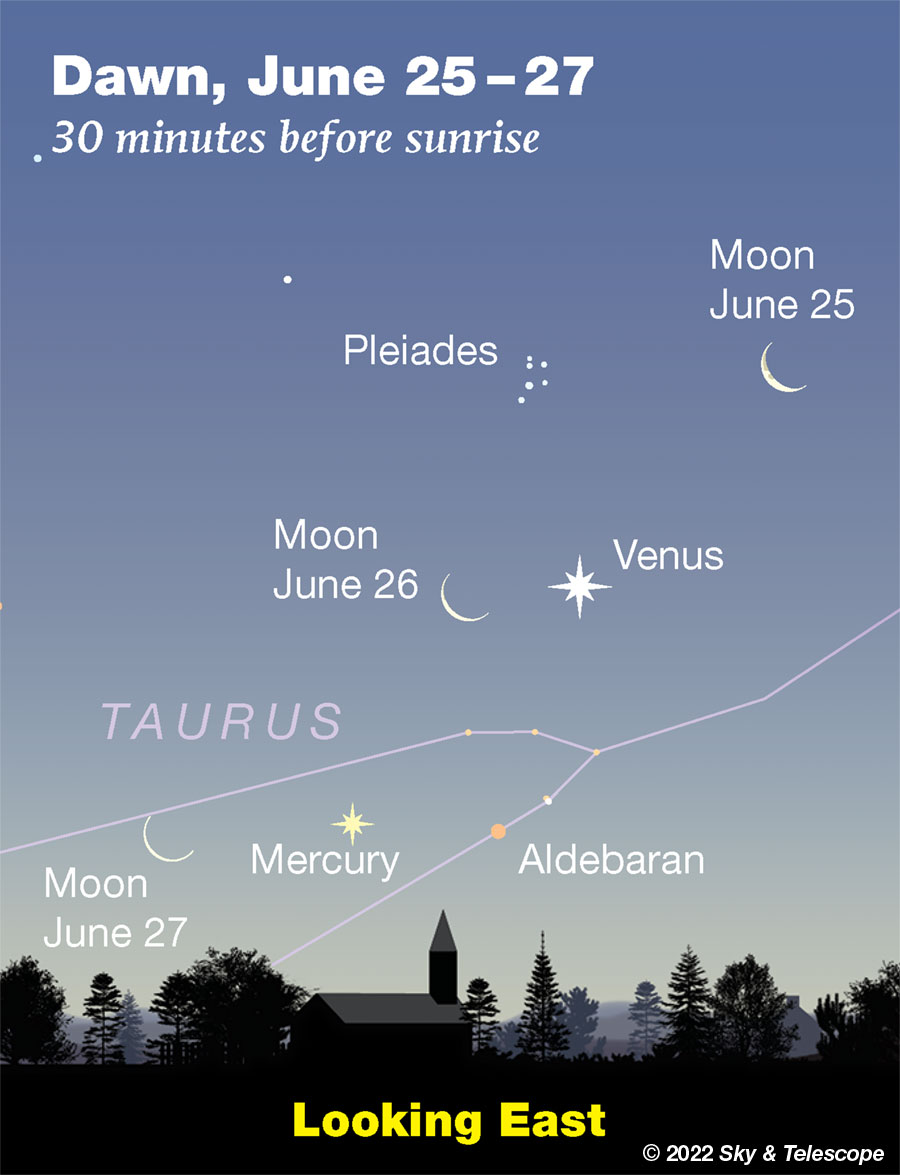
SATURDAY, JUNE 25
■ This is the time of year when the two brightest stars of summer, Arcturus and Vega, are about equally high overhead soon after dark: Arcturus toward the southwest, Vega toward the east.
Arcturus and Vega are 37 and 25 light-years away, respectively. They represent the two commonest types of naked-eye star: a yellow-orange K giant and a white A main-sequence star. They're 150 and 50 times brighter than the Sun, respectively — which, combined with their nearness, is why they dominate the evening sky.
■ Low in the dawn of Sunday the 26th, the waning crescent pairs with Venus, as shown above.
SUNDAY, JUNE 26
■ Low in the northwest or north at the end of these long summer twilights, would you recognize noctilucent clouds if you saw them? They're the most astronomical of all cloud types, what with their extreme altitude and their formation (in part) on meteoric dust particles. They used to be fairly rare, but they've become more common in recent years as Earth's atmosphere changes. See Bob King's Nights of Noctilucent Clouds.
■ Very low in the brightening dawn Monday the 27th, the thin crescent Moon hangs left of Mercury as shown above. Binoculars will help.
MONDAY, JUNE 27
■ Today's sunset is the latest of the year (if you live near latitude 40° north), even though the solstice was on the 21st. This slight discrepancy, amounting to only a minute or so, arises from the tilt of Earth's axis and the ellipticity of Earth's orbit — like the somewhat larger winter equivalent in December, which moves the earliest sunset from the solstice to about December 7th.
TUESDAY, JUNE 28
■ Look for the Big Dipper hanging straight down in the northwest as soon as darkness is complete. Its bottom two stars, the Pointers, point toward modest Polaris to their lower right, by about three fists at arm's length.
Polaris is the end of the Little Dipper's handle. From there the rest of the Little Dipper floats upward. Perhaps it's a helium balloon escaped from some June evening party, trailing its string. Through light pollution, however, all you may see of the Little Dipper are Polaris at its bottom and Kochab, the lip of the Little Dipper's bowl, at the top. The rest of its stars are pretty dim at 3rd to 5th magnitude.
■ New Moon (exact at 10:52 p.m. EDT).
WEDNESDAY JUNE 29
■ Arcturus and Vega are about equally far from straight overhead shortly after dark: Arcturus toward the southwest, Vega toward the east.
Arcturus is pale yellow-orange; Vega is icy bluish white. Star colors are mostly subtle, and different people have an easier or harder time seeing them. To me, the tints of bright stars show a little better in the dark blue of a late-twilight sky than in a fully dark sky.
For instance, compare Vega and Arcturus in twilight and after dark. Do their colors stand out a little better or worse for you one way or the other?
Binoculars, of course, always make star colors much more obvious.
THURSDAY, JUNE 30
■ Leo the Lion is mostly a constellation of late winter and spring evenings. But he's not gone yet. As twilight ends look due west, somewhat low, for Regulus, his brightest and now lowest star: the forefoot of the Lion stick figure.
The Sickle of Leo extends upper right from Regulus. The rest of the Lion's constellation figure runs for two or three fist-widths to the upper left from there, to his tail star Denebola, the highest. He'll soon be treading offstage into the sunset.
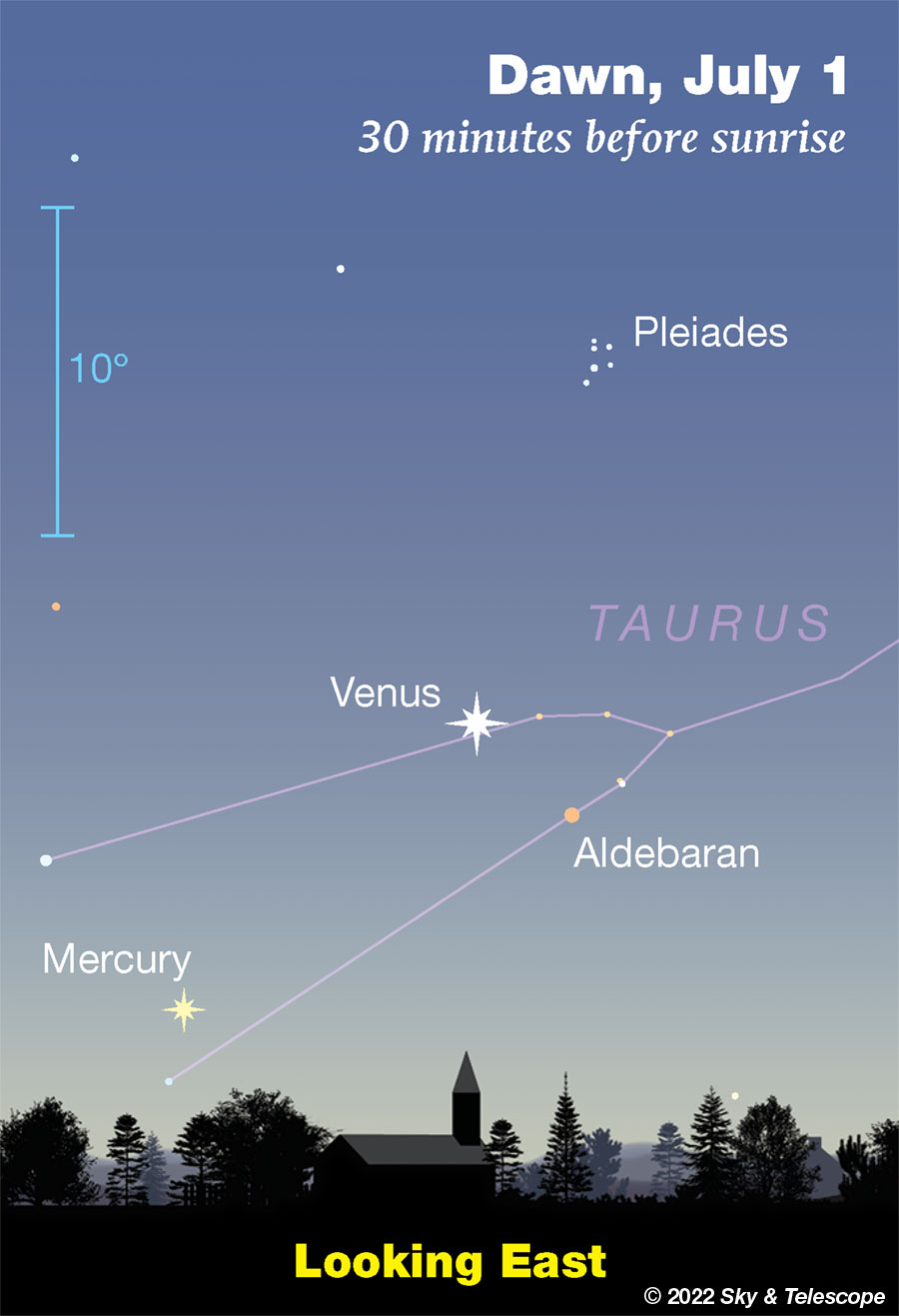
FRIDAY, JULY 1
■ On the eastern side of the sky, the Summer Triangle holds sway after dark. Its top star is Vega, the brightest on that entire half of the sky. The brightest star to Vega's lower left is Deneb. Farther to Vega's lower right is Altair, with fainter Tarazed just above it. The Milky Way (if you have deep darkness) runs across the Triangle just inside its bottom edge.
As evening grows late and even Altair rises high, look left or lower left of it, by hardly more than a fist, for the compact little constellation Delphinus, the Dolphin.
Did you get it? Then try for even fainter, smaller Sagitta, the Arrow. It's to Altair's upper left, just a little closer. The Arrow points lower left, past the head of Delphinus.
SATURDAY, JULY 2
■ In twilight this evening, look west for the waxing crescent Moon. Look left of the Moon for Regulus and above the Moon for slightly fainter Algieba, Gamma Leonis, as shown below. Binoculars help reveal the color difference between the two stars. Algieba is a wide optical double for binoculars and a much closer true binary (5 arcseconds) for telescopes.
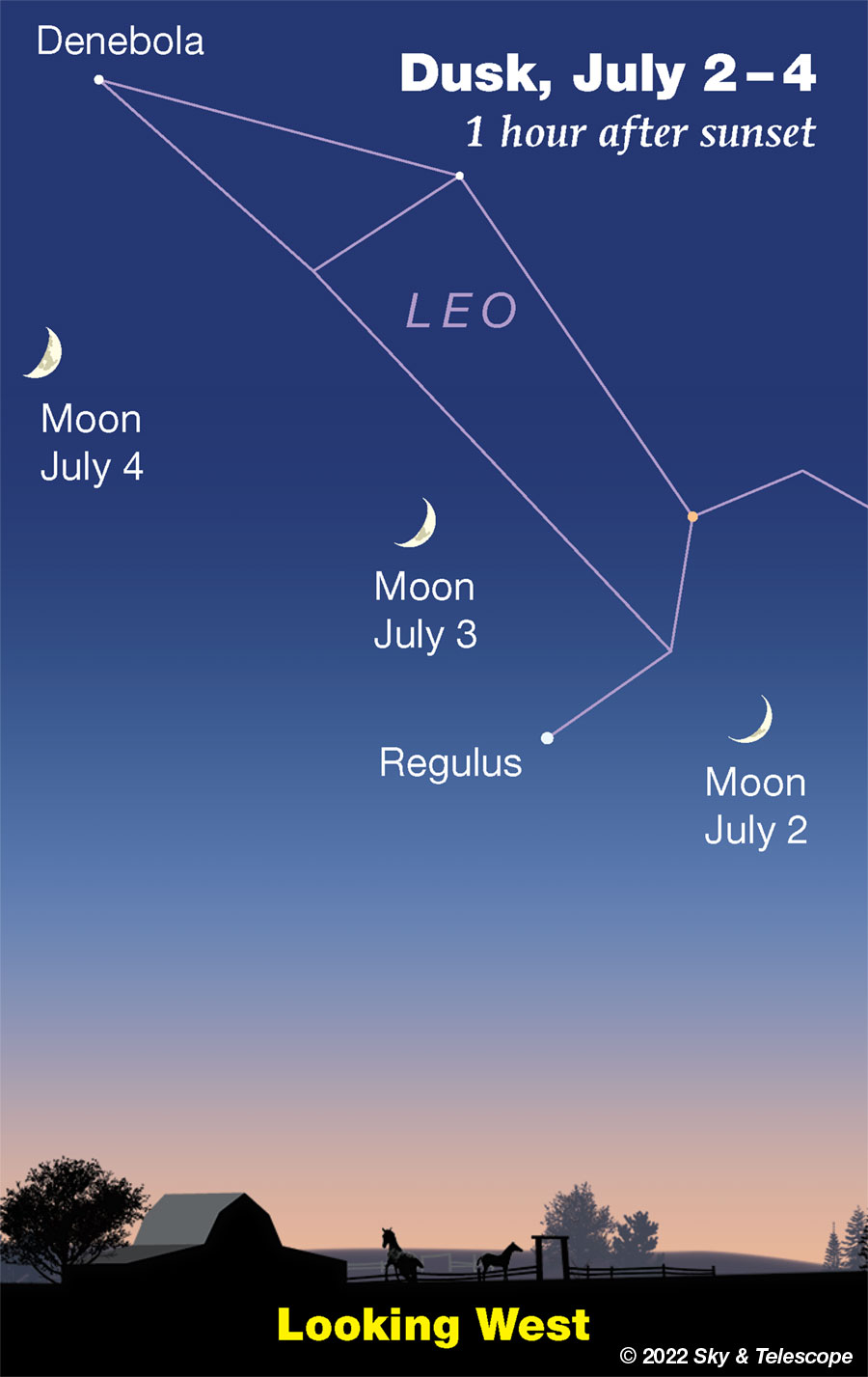
This Week's Planet Roundup
Seven dawn planets! All five naked-eye planets remain lined up in the dawn, in good view for most of this week. From Mercury through Saturn, they run from low in the east-northeast to high in the south as dawn brightens.
By coincidence, they happen to be arranged in order of their distance from the Sun, counting from lower left to upper right. Dim, sub-naked-eye Uranus and Neptune also lurk among them.
Mercury is low in the glow of sunrise, glimmering 10° to 13° lower left of bright Venus this week. See the scene at the top of this page. Mercury sinks a little lower into the sunrise day by day, even as it brightens from magnitude –0.2 to –0.8. Binoculars help.
Fainter Aldebaran, magnitude +0.8, sparkles weakly in Mercury's vicinity.
Venus (magnitude –3.9) rises just as dawn begins. Look for it above the east-northeast horizon. It's very far lower left of bright Jupiter, by roughly six fists at arm's length.
Mars and Jupiter, very different at magnitudes +0.5 and –2.4 respectively, shine in the east-southeast before and during early dawn, near the Pisces-Cetus border. Mars glows to Jupiter's lower left. They continue to move apart, separating from 16° to 20° this week.
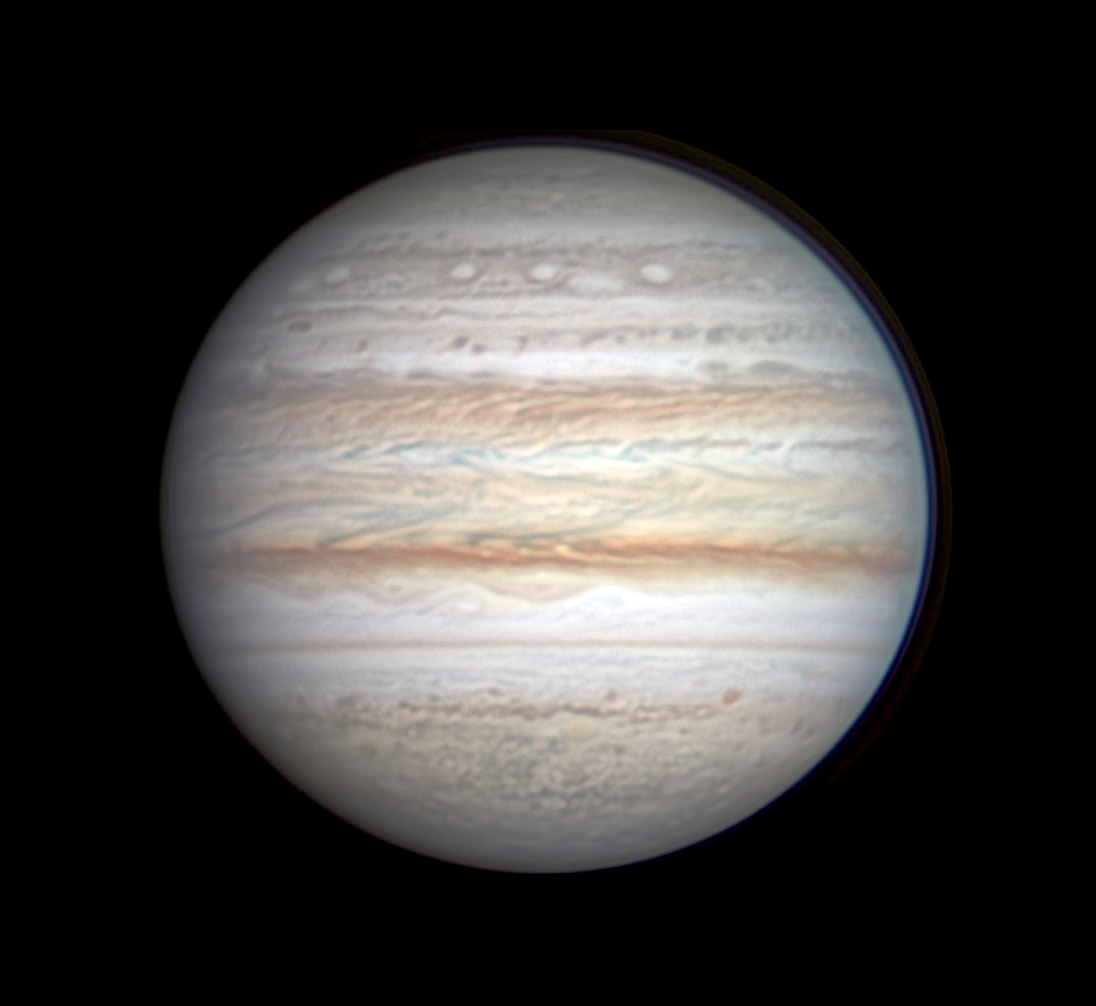
Saturn, magnitude +0.7, rises around 11 p.m. in eastern Capricornus. By the beginning of dawn you'll find it in the south. It's some 40° (about four fists) to the right of Jupiter.
The little star less than 2° to Saturn's lower right is Delta Capricorni, magnitude 2.8. Saturn has stayed near Delta Cap for weeks, because the planet is near its stationary point: the eastern end of the retrograde loop on the sky that it performs every 12½ months. Delta Cap will keep fairly close company with Saturn all the way through August.
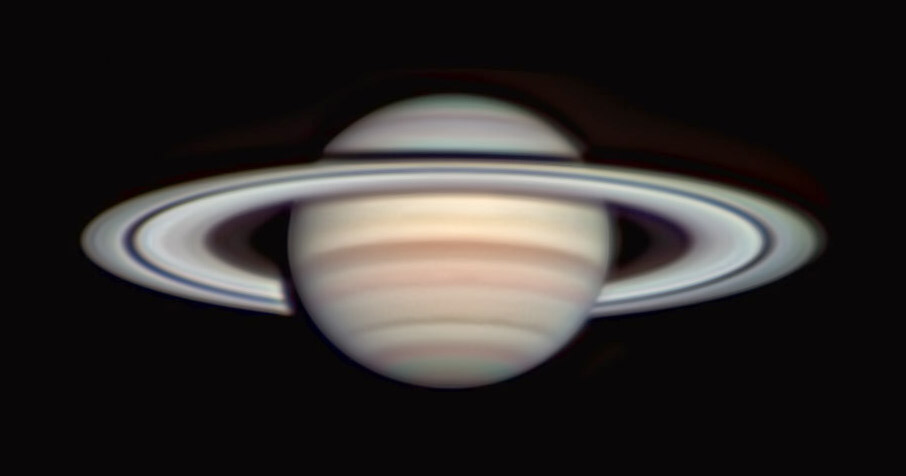
Uranus, magnitude 5.8 in Aries, is low in the east before the first light of dawn, between Venus and Mars.
Neptune, magnitude 7.9 at the Aquarius-Pisces border, is high in the southeast before the first light of dawn, between Jupiter and Saturn.
All descriptions that relate to your horizon — including the words up, down, right, and left — are written for the world's mid-northern latitudes. Descriptions and graphics that also depend on longitude (mainly Moon positions) are for North America.
Eastern Daylight Time, EDT, is Universal Time minus 4 hours. (Universal Time is also called UT, UTC, GMT or Z time.)
Want to become a better astronomer? Learn your way around the constellations. They're the key to locating everything fainter and deeper to hunt with binoculars or a telescope.
This is an outdoor nature hobby. For an easy-to-use constellation guide covering the whole evening sky, use the big monthly map in the center of each issue of Sky & Telescope, the essential magazine of astronomy.
Once you get a telescope, to put it to good use you'll need a detailed, large-scale sky atlas (set of charts). The basic standard is the Pocket Sky Atlas (in either the original or Jumbo Edition), which shows stars to magnitude 7.6.

Next up is the larger and deeper Sky Atlas 2000.0, plotting stars to magnitude 8.5; nearly three times as many. The next up, once you know your way around, are the even larger Interstellarum atlas (stars to magnitude 9.5) or Uranometria 2000.0 (stars to magnitude 9.75). And be sure to read How to Use a Star Chart with a Telescope. It applies just as much to charts on your phone or tablet as to charts on paper.
You'll also want a good deep-sky guidebook. A beloved old classic is the three-volume Burnham's Celestial Handbook. An impressive more modern one is the big Night Sky Observer's Guide set (2+ volumes) by Kepple and Sanner.
Can a computerized telescope replace charts? Not for beginners, I don't think, and not on mounts and tripods that are less than top-quality mechanically, meaning heavy and expensive. And as Terence Dickinson and Alan Dyer say in their Backyard Astronomer's Guide, "A full appreciation of the universe cannot come without developing the skills to find things in the sky and understanding how the sky works. This knowledge comes only by spending time under the stars with star maps in hand."
![]() Audio sky tour. Out under the evening sky with your
Audio sky tour. Out under the evening sky with your
earbuds in place, listen to Kelly Beatty's monthly
podcast tour of the heavens above. It's free.
"The dangers of not thinking clearly are much greater now than ever before. It's not that there's something new in our way of thinking, it's that credulous and confused thinking can be much more lethal in ways it was never before."
— Carl Sagan, 1996
"Facts are stubborn things."
— John Adams, 1770
 7
7









Comments
Rod
June 25, 2022 at 8:48 am
Well, I almost viewed the Moon, Uranus, Mars, Jupiter, Neptune, and Saturn this morning using my telescope. 0510 EDT, the ecliptic view was great, I could see the waning crescent Moon in Aries with earthshine, Mars, Jupiter, and Saturn naked eyes. Sunrise near 0543 EDT. However, I needed more comfort this morning so went back to bed vs. setup in the fields near 0400 EDT to catch the sky show 🙂 Perhaps tonight after 2200 EDT I will use my 90-mm refractor telescope and enjoy some views in Cygnus when it rises higher including Albireo double star.
You must be logged in to post a comment.
Rod
June 25, 2022 at 11:44 pm
I did get out under the stars tonight and observe. [Observed 2145-2300 EDT. Sunset 2035 EDT. New Moon 29-June-2022 0252 UT. I used 10x50 binoculars and 90-mm refractor telescope with TeleVue 14-mm Delos for 71x views with true FOV a bit more than 1-degree across. M39 easy view in 10x50 binoculars, M29 better using the telescope. Albireo was lovely double star at 71x. Golden-yellow star and blue star, so lovely a sight. M57 in Lyra at 71x was easy to see, distinct ring shape but the XT10i does a much better job. M71 at 71x distinct but looked more like a faint open cluster. M11 in Scutum I viewed using 10x50 binoculars. Using 10x50 binoculars, M4 and M13 distinct fuzzy balls as globular clusters. Some interesting summer targets viewed tonight using 10x50 binoculars and 90-mm refractor telescope. Skies clear, temperature 22C, winds south 5 knots. A bit humid tonight and June fireflies all around in the fields, pastures, and woods.]
You must be logged in to post a comment.
Rod
June 26, 2022 at 8:05 am
For any interested, the evening sky after 2200 EDT in my location is a target rich environment from Cygnus through Scorpius now. The early morning sky is rich with planets and the late-night sky, has many riches to enjoy 🙂
You must be logged in to post a comment.
mary beth
June 26, 2022 at 11:26 pm
Very much enjoyed your reports Rod. Like your description of the colors of Albireo! I looked it up and saw a nice picture depicting what you said, I bet it was really amazing in the telescope . You are fortunate to have fireflies, they are really on the decline sadly. Rarely see them here. Such a treat when we do! Glad you enjoyed the morning planet parade! Hope you have clear evening skies. We have thoroughly been enjoying Scorpius: lovely orange Antares and all four cat’s eyes. Seeing the teapot over the trees.
You must be logged in to post a comment.
Rod
June 28, 2022 at 10:42 am
If you use binoculars, you should be able to see M4 a bit more than 1-degree angular separation from Antares in Scorpius. 8-to-10-inch telescopes will show an excellent view of the globular cluster. In my 10x50 binoculars, M4 is a very distinct fuzzy ball near Antares.
You must be logged in to post a comment.
Rod
June 28, 2022 at 10:46 am
30-June looks like a good time for me to view Mars, Jupiter, Neptune, and Saturn near 0400 EDT at my location using binoculars and telescope. Uranus and Venus will be low behind a tree line at my site. To the right of Jupiter some 10-11 degrees is any easy 4-star asterism, star hope into Neptune position. 29 Psc, 27 Psc, 24 Psc, and 20 Psc, Neptune a bit more than 1-degree from 20 Psc. Go time should be 0400 EDT 30-June for me 🙂
You must be logged in to post a comment.
Rod
June 30, 2022 at 9:36 am
I was able to view Mars, Jupiter, Neptune, and Saturn this morning. I placed a note here for 30-June viewing using 10x50 binoculars. https://skyandtelescope.org/astronomy-news/solar-system-gets-its-ducks-in-a-row/
You must be logged in to post a comment.
You must be logged in to post a comment.